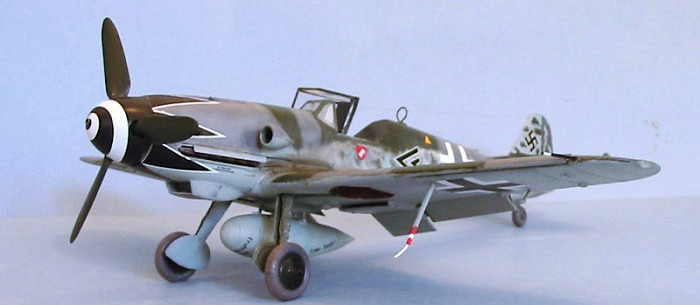
| KIT: | Hasegawa 1/32 Bf-109G-10 'type 110 cowl' |
| KIT #: | ? |
| PRICE: | $44.95 MSRP |
| DECALS: | Three options |
| REVIEWER: | Tom Cleaver |
| NOTES: | Cutting Edge type 110 cowl conversion used |

| HISTORY |
By the Spring of 1944, the Bf-109G-6, which had been the primary production version of Messerschmitt’s fighter since the previous fall, was falling behind in the relentless race for performance. Beginning in the late spring, many airframes were re-engined with the DB605D, on which an increased-diameter supercharger had been fitted and compression raised to from 7.3/7.5 to 8.3/8.5, using standard B4 (87 octane) fuel with methanol-water (MW50) injection, to provide 1,800 h.p. for take-off and 1,600 h.p. at 6,000 meters. That summer, production “standardized” on the Bf-109G-14, which could use this engine or the DB605CD, which utilized C3 (96 octane) fuel and MW50 to provide 2,000 h.p. for take-off and 1,800 h.p. at 6,000 meters.
That fall, the redesigned Bf-109K-4 came into production and reached the Jagdwaffe beginning in mid-November 1944.
The Bf-109G-10 began life as a way of modernizing the Bf-109G-6 airframe to make
it as much like a Bf-109K as possible. This version, all of which were
re-manufactured G-6 airframes, did not enter service until January 1945, after
the introduction of the Bf-109K-4, which has spread no small amount of confusion
among Bf-109 “experten”. Coupled with the fact that the G-10 could appear with
either engine, with or without an extended-le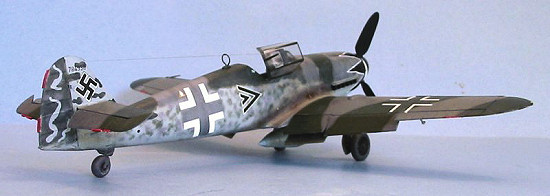 g
tail wheel like the K-4, with or without the taller wooden rudder of the K-4,
G-14, and late production G-6, and with or without the larger wheels and
associated upper wing fairing of the K-4 variant, it is close to impossible
unless one can discern a Werkenummer in a photograph, and has access to a
list of sub-types by serial number (and even then it is not a 100% lock since
the records are not totally complete), to determine if one is looking at a
Bf-109G-6AS, a Bf-109G-14AS, or a Bf-109G-10. There are few photos available of
any of these late war types to top it off. The only version of the Bf-109G-10
that can absolutely be identified as such is the Erla-built version, due to the
fact that it lacked the curved cowling fairing on the left side of the forward
fuselage immediately below the windscreen, this being replaced by a
square-shaped panel. Additionally, this sub-type does not have under cowl
bulges on the lower nose, and does have a shallower, wider oil cooler radiator.
g
tail wheel like the K-4, with or without the taller wooden rudder of the K-4,
G-14, and late production G-6, and with or without the larger wheels and
associated upper wing fairing of the K-4 variant, it is close to impossible
unless one can discern a Werkenummer in a photograph, and has access to a
list of sub-types by serial number (and even then it is not a 100% lock since
the records are not totally complete), to determine if one is looking at a
Bf-109G-6AS, a Bf-109G-14AS, or a Bf-109G-10. There are few photos available of
any of these late war types to top it off. The only version of the Bf-109G-10
that can absolutely be identified as such is the Erla-built version, due to the
fact that it lacked the curved cowling fairing on the left side of the forward
fuselage immediately below the windscreen, this being replaced by a
square-shaped panel. Additionally, this sub-type does not have under cowl
bulges on the lower nose, and does have a shallower, wider oil cooler radiator.
What is known definitely about the Bf-109G-10 is that it was the final type to equip Squadrigli of the Aviazione della R.S.I., as well as the last type to equip the Croatian Jagdstaffel that flew with the Italians in the last months of the war, and that it was issued interchangeably with the Bf-109K-4 to Luftwaffe Geschwadern in the last months of the war. It was acknowledged as the fastest of the series, with a top speed at altitude of 452 m.p.h., slightly faster than the Bf-109K-4. As far as having any effect on the war, the airplane may as well not have existed; by the time it arrived, the Luftwaffe had shot its final bolt in Operation Bodenplatte, and was a spent force with few leaders left alive, fewer pilots of any ability left on operations, and an uncertain supply of aviation gasoline which meant most of these airplanes were supplied to a unit that never flew them before they were lost to Allied strafing in the few months after the Battle of the Bulge that spelled the end of the Nazis and their “Thousand-Year Reich.”
Erich Hartmann:
Erich Hartmann’s name is well-known to aviation enthusiasts as the highest-scoring ace of all history with 352 aerial kills.
This
score is even more amazing when one considers that he did not arrive at the
front until the summer of 1942 - well past the "glory days" of the Luftwaffe.
Once he got over his "buck fever" - he turned tail and ran when he entered his
first combat - Hartmann was a gifted pilot in a target-rich environment. He was
always outnumbered by his Soviet foes. Flying three and four missions a day
every day, he had over 100 victories by the conclusion of the Battle of Kursk in
July 1943 - a year after he entered
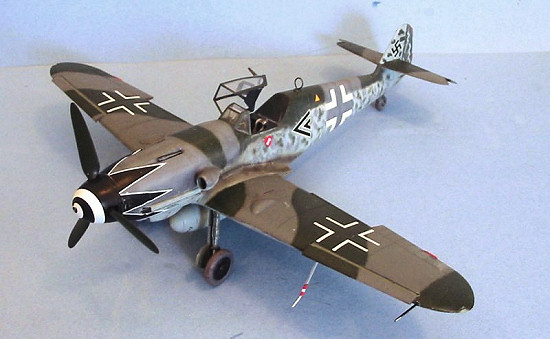 combat - and another 100 by
the end of 1943. Beginning with the mission of July 7, 1943, Hartmann began
scoring multiple victories because he had learned the essential trick of a
successful fighter pilot, to close to point-blank range before opening fire.
This way, it only took three or four hits with his 20mm cannon to explode an
enemy fighter. As he put it, "Get close. When he fills the entire windscreen,
then you can’t possibly miss." . Hartmann claimed that - of all his
accomplishments - he was proudest of the fact that he never lost a wingman.
combat - and another 100 by
the end of 1943. Beginning with the mission of July 7, 1943, Hartmann began
scoring multiple victories because he had learned the essential trick of a
successful fighter pilot, to close to point-blank range before opening fire.
This way, it only took three or four hits with his 20mm cannon to explode an
enemy fighter. As he put it, "Get close. When he fills the entire windscreen,
then you can’t possibly miss." . Hartmann claimed that - of all his
accomplishments - he was proudest of the fact that he never lost a wingman.
Born in 1922, in Weissach, Wurttemberg, Hartmann joined the Luftwaffe in 1941 at age 19, and was posted to Jagdgeschwader 52 on the Eastern Front in October, 1942. He scored his first kill that November, and only achieved his second three months later.
As he worked out the tactics which would prove so successful later on during the Spring of 1943, he would normally be content with one victory, being willing to wait for another day. His natural talents began to tell: excellent eyesight, lightning reflexes, an aggressive spirit, and an ability to stay cool while in combat. As he developed the coolness to close with the enemy, he started scoring multiple victories, such as his missions on February 26, 1944, when he scored his 200th victory. That day, he shot down ten P-39 Airacobras over three sorties.
In June and July 1944, operating in Romania, Hartmann engaged in combat with American fighters for the first time, and shot down six, including American ace Ralph “Kidd” Hofer, one of the “personalities” of the Fourth Fighter Group when that unit operated in Italy after taking part in the first shuttle mission to the USSR in late June.
Over the month of August 1944, Hartmann claimed 35 victories, including eight on August 23, which was followed the next day by shooting down 11 enemy aircraft to become the first pilot to score more than 300 victories.
Following this, Hartmann was prohibited from flying combat and assigned to
Erprobungskommando 262. In October, the prohibition on combat flying was
lifted and he was appointed Staffelkapitän of 4./JG 52, then in Hungary.
By the end of the year, his tally was 331. Hartmann briefly led I/JG 53 as
acting 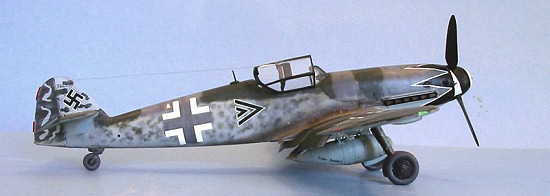 Gruppenkommandeur
from February 1-14, 1945, before turning over command to Hauptmann Helmut
Lipfert and becoming Gruppenkommandeur of I/JG 52. In March he was
transferred to Lechfeld for training on the Me 262 to join JV 44, but he
requested a return to JG 52, due to his feeling that the young pilots needed his
skills more than the experten of JV 44 did. On April 17, he scored his
350th victory, and was promoted to Major at the end of the month. On
May 8 - the last day of the war - he claimed his 352nd, and last, victory
against a Yak-9 over the Brün area in Czechoslovakia.
Gruppenkommandeur
from February 1-14, 1945, before turning over command to Hauptmann Helmut
Lipfert and becoming Gruppenkommandeur of I/JG 52. In March he was
transferred to Lechfeld for training on the Me 262 to join JV 44, but he
requested a return to JG 52, due to his feeling that the young pilots needed his
skills more than the experten of JV 44 did. On April 17, he scored his
350th victory, and was promoted to Major at the end of the month. On
May 8 - the last day of the war - he claimed his 352nd, and last, victory
against a Yak-9 over the Brün area in Czechoslovakia.
Later that day, the Luftwaffe command ordered Hartmann and his Kommodore, Hermann Graf, to fly to the British sector. Both disregarded the order because they were responsible for Jagdgeschwader 52's pilots, ground crew, family members, and other civilians who had joined the squadron seeking protection against Czech partisans. They ordered the destruction of the unit’s aircraft, then moved west. At the end of the day, they surrendered to the U.S. Army on the Bavarian-Czech border. However, on May 17th, the Americans delivered members of JG 52 to the Soviets.
With the rest of the unit, Hartmann was sent to Siberia, where he was sentenced to 50 years at hard labor. During his imprisonment, the Soviets pressured him to support the establishment of an East German air force and tried to turn him into an undercover agent against the West. He refused, even though the Soviets threatened to kidnap and kill his wife and daughter, who were living in West Germany. Hermann Graf accepted the offer and was released from the gulag in 1953. Hartmann returned to Germany on October 15, 1955, when the last German POWs were released following the establishment of diplomatic relations between West Germany and the Soviet Union.
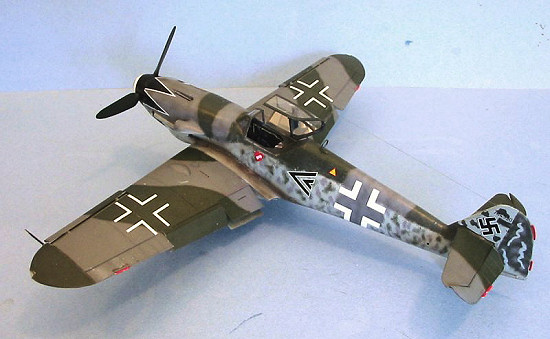 In 1956, he joined the
newly-established Bundesluftwaffe and in 1959 became the first
Kommodore of Jagdgeschwader 71 "Richthofen." His career suffered when
he opposed the introduction of the F-104 Starfighter into the Luftwaffe on
grounds that the service did not have the experience to successfully operate
such a high performance jet at that time, an opinion later proven right with the
horrendous loss rate and fatalities following the F-104's entry into operations
up until the mid-1970s.
In 1956, he joined the
newly-established Bundesluftwaffe and in 1959 became the first
Kommodore of Jagdgeschwader 71 "Richthofen." His career suffered when
he opposed the introduction of the F-104 Starfighter into the Luftwaffe on
grounds that the service did not have the experience to successfully operate
such a high performance jet at that time, an opinion later proven right with the
horrendous loss rate and fatalities following the F-104's entry into operations
up until the mid-1970s.
Retiring as a Colonel in 1970 over these severe differences with his old comrade Gunter Rall - the leader of the F-104 faction in the Bundesluftwaffe - Erich Hartmann died in 1993. He had flown 825 missions in recording 352 victories, a record for endurance in combat. His victories included 15 Il-2 Sturmoviks. He was shot down and force-landed 14 times during his combat career.
| THE KIT |
Hasegawa’s series of 1/32 Bf-109s now includes all major variants of the G and K series, and is one of the best 1/32 kits available. The kits have been reviewed many times elsewhere.
The Cutting Edge resin conversion, CEC32139, allows a modeler to build the Erla "Type 110" Bf-109G-10, and includes a completely new cowling and all fairings, for $29.99.
| CONSTRUCTION |
I had done this conversion before, and had put that model out at Planes of Fame for display. I hadn’t really been that happy with the final result of that project, so when the opportunity presented itself for a “mulligan,” I picked up the kit and the conversion set from a friend who had decided the project was more than he felt comfortable with.
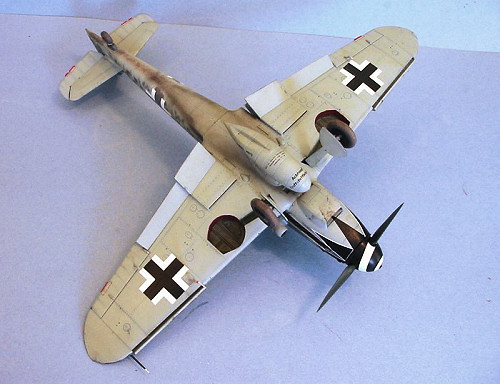 Since I doubt there is a
modeler who builds 1/48 World War II aircraft who hasn't done at least one each
of the Hasegawa 109s, I will merely state here that construction of the 1/32 kit
is straightforward and easy if one follows the instructions - perhaps even
easier than the 1/48 kits. The basic 109F/G/K wing has holes to be drilled out
for the upper wing wheel bulges and the FuG16zy Morane antenna. The
cockpit is sparse in its detail though acceptable (and much more than you get in
1/48 scale), and the model will benefit from an aftermarket resin cockpit, as I
used here, this one being one of the excellent cockpits offered by Cutting Edge,
in this case being a cockpit for a Bf-109G-6, since I decided this Bf-109G-10
had been rebuilt from a G-6 (how’s that for a fancy way of saying “I used the
cockpit I had”???). I also decided, after looking at some pictures of
identifiable Erla-built G-10s, that the majority seemed to have the short tail
wheel (another fancy way of saying “I didn’t want to get into scratchbuilding a
long tailwheel leg”). These really were easy choices, since there are no detail
photos of the particular airplane I was re-creating. (If you want a more
detailed look at adapting the type 110 cowling to the kit, then visit your
editor's build. Ed)
Since I doubt there is a
modeler who builds 1/48 World War II aircraft who hasn't done at least one each
of the Hasegawa 109s, I will merely state here that construction of the 1/32 kit
is straightforward and easy if one follows the instructions - perhaps even
easier than the 1/48 kits. The basic 109F/G/K wing has holes to be drilled out
for the upper wing wheel bulges and the FuG16zy Morane antenna. The
cockpit is sparse in its detail though acceptable (and much more than you get in
1/48 scale), and the model will benefit from an aftermarket resin cockpit, as I
used here, this one being one of the excellent cockpits offered by Cutting Edge,
in this case being a cockpit for a Bf-109G-6, since I decided this Bf-109G-10
had been rebuilt from a G-6 (how’s that for a fancy way of saying “I used the
cockpit I had”???). I also decided, after looking at some pictures of
identifiable Erla-built G-10s, that the majority seemed to have the short tail
wheel (another fancy way of saying “I didn’t want to get into scratchbuilding a
long tailwheel leg”). These really were easy choices, since there are no detail
photos of the particular airplane I was re-creating. (If you want a more
detailed look at adapting the type 110 cowling to the kit, then visit your
editor's build. Ed)
There is a lot of cutting and fitting to be done in attaching the resin cowling to the fuselage, but this is no problem for anyone who has a couple of conversions under their belt. The parts are designed to fit the Bf-109G-14 kit, and are overall excellent.
Once the resin cockpit was freed from its molding blocks, it was painted and detailed, then installed in the fuselage. Construction was straightforward past that.
| COLORS & MARKINGS |
There are not many photographs of late war Bf-109G-10s, and there is only one
photograph still in existence of the Bf-109G-10 that Hartmann flew at the end of
the war. This shows that the airplane was an Erla-built “Type 110" (since you
can see the flat panel on the left forward fuselage) and that the fuselage was
moderately mottled. Thus, I painted the model in a late-war standard Erla
scheme for the upper wings and tail surfaces, using Xtracrylix RLM 75
Grauviolett, RLM 82 Dunkelgrun and RLM 76 Blaugrau paints,
freehanding the camouflage with my Paasche-H and going for the “splat” look of
the blotches, as seen in the photos Brett Green took of the only Bf-109G still
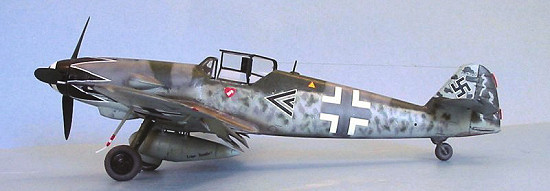 in original paint, at the
Australian War Memorial. I painted the “hard edge” mottles on the vertical fin
with a brush, as well as the RLM 76 squiggles on the rudder. When this was done,
I gave the model an overall coat of Xtracrylix Gloss varnish.
in original paint, at the
Australian War Memorial. I painted the “hard edge” mottles on the vertical fin
with a brush, as well as the RLM 76 squiggles on the rudder. When this was done,
I gave the model an overall coat of Xtracrylix Gloss varnish.
Decals:
I pieced together markings for this from Aeromaster and Eagle Editions sheets that had markings for Hartmann’s other airplanes. While he dropped the use of the black tulip petals after putting them on his Bf-109G-6 “Weiss Ein” in the fall of 1943, due to the danger of becoming too well-known to the Soviets were he shot down, he put the marking back his Bf-109G-14 when he became Gruppenkommandeur of I/JG 53, as a way of raising the morale of the young, undertrained Nachwuchs he commanded, and he retained those markings on his Bf-109G-10 when he took over I/JG 52 for the same reason. I used the “Usch” heart he had on the Bf-109G-14 in I/JG 53, reasoning he would have used a similar simplified marking on this last airplane. The Gruppenkommandeur’s double chevrons came from a left-over Hasegawa kit decal sheet for the Fw-190D-9
| FINAL CONSTRUCTION |
Reasoning that Hartmann had this airplane - which he later said was his favorite of all the 109s he flew - for only about seven weeks at the maximum, during which time the unit did not fly every day due to fuel shortages, I decided it likely it had not had much time to get “dinged” or faded, and thus limited the wear and tear to exhaust stains on the fuselage sides and the bottom of the airplane.
| CONCLUSIONS |
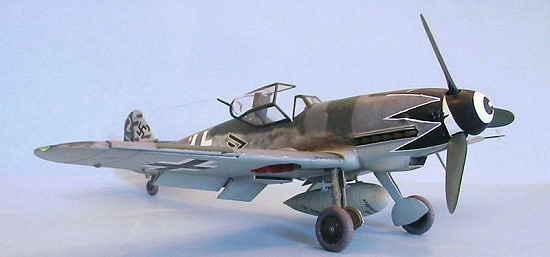 For someone who doesn’t
consider himself a member of the 109Nutz Fraternity, I certainly seem to have
collected and built a fair number of these 1/32 Hasegawa 109s (and I know of two
or three more that will grace the shelves soon). The kit goes together so well
that an average modeler can come up with an excellent model out of the box.
Then there is the myriad of camouflage patterns, colors, and markings that are
possible (my favorite part of modeling is painting and decals). I like these
better than the 1/48 kits, but that’s likely due - as SWMBO says - to the fact
that “artists like big canvases.”
For someone who doesn’t
consider himself a member of the 109Nutz Fraternity, I certainly seem to have
collected and built a fair number of these 1/32 Hasegawa 109s (and I know of two
or three more that will grace the shelves soon). The kit goes together so well
that an average modeler can come up with an excellent model out of the box.
Then there is the myriad of camouflage patterns, colors, and markings that are
possible (my favorite part of modeling is painting and decals). I like these
better than the 1/48 kits, but that’s likely due - as SWMBO says - to the fact
that “artists like big canvases.”
Kit and conversion set courtesy my wallet.
May 2006
If you would like your product reviewed fairly and quickly by a site that has over 300,000 visitors a month, please contact me or see other details in the Note to Contributors.